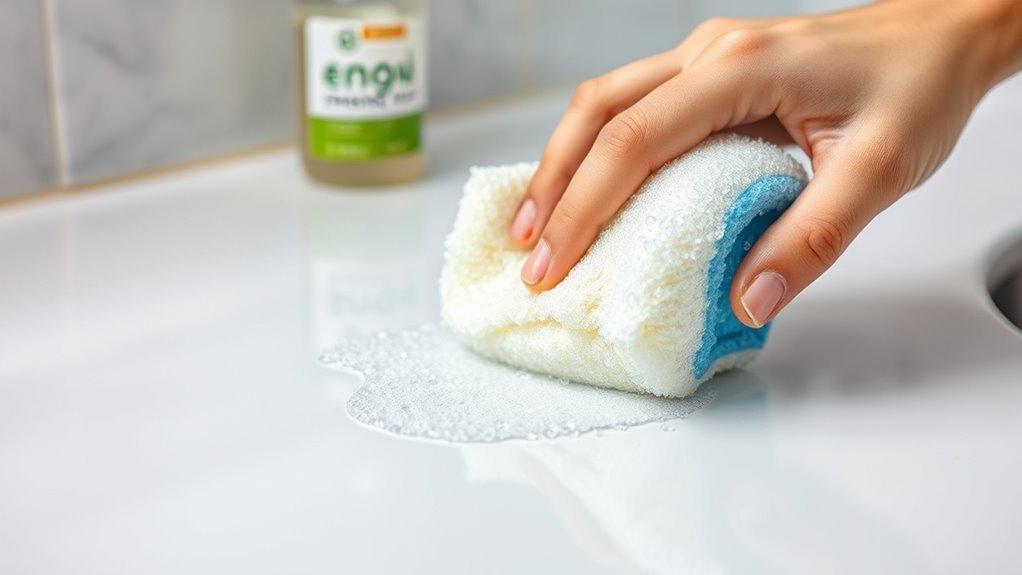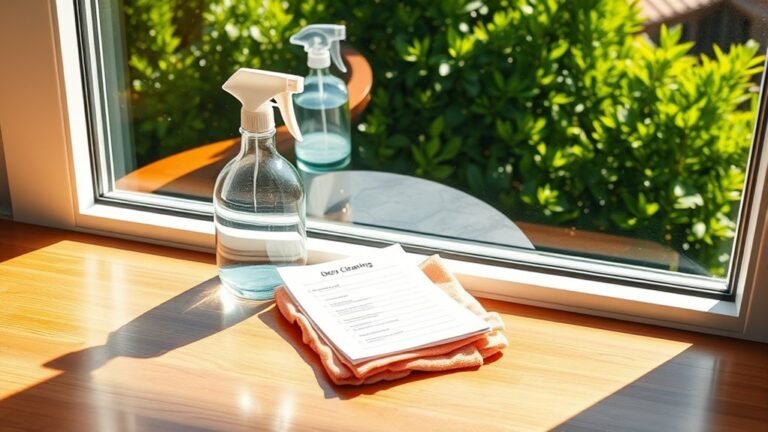Removing Stains From Bathroom Effectively
To remove bathroom stains effectively, start by identifying the type—like soap scum, hard water deposits, or mold. Use the right tools: scrub brushes, microfiber cloths, and gentle cleaners such as vinegar or baking soda. Spray vinegar solutions on hard water stains, scrub softly, and rinse well. For soap scum, lemon juice or commercial removers work wonders. Keep your space well-ventilated and wipe surfaces dry to prevent buildup. With these basics, you’ll find cleaner, fresher results and tips for ongoing care ahead.
Identifying Common Bathroom Stains

Before you can effectively remove stains from your bathroom, you need to know what you’re dealing with. Understanding the common sources and stain characteristics helps you tackle them with confidence. You’ll often find hard water stains caused by mineral deposits, appearing as white, chalky marks on faucets and tiles. Soap scum, a stubborn residue from soap and body oils, leaves a filmy layer that’s tough to wipe away. Rust stains from metal fixtures or water with high iron content show up as reddish-brown spots. Mold and mildew thrive in damp areas, presenting as black or green patches. By recognizing these common sources and their unique stain characteristics, you gain the freedom to choose the right approach and restore your bathroom’s cleanliness efficiently and effectively.
Essential Cleaning Tools and Supplies
Though knowing what stains you’re up against is essential, having the right tools and supplies makes all the difference in removing them effectively. You want to feel free from stubborn marks, and that starts with equipping yourself properly. Here are three essential cleaning tools and supplies you shouldn’t skip:
- Scrub brushes and sponges – Different textures help tackle various surfaces without damage.
- Multi-purpose cleaners – Choose ones designed for bathroom use to break down grime and stains quickly.
- Protective gloves – Keep your hands safe while you work, so cleaning doesn’t feel like a chore.
With these essentials in hand, you’ll be ready to restore your bathroom’s shine and enjoy a fresh, stain-free space without hassle.
Removing Soap Scum From Surfaces

When it comes to removing soap scum, choosing the right cleaner makes all the difference. You’ll want to use products specifically designed to break down the buildup without damaging your surfaces. Plus, establishing simple habits can help prevent soap scum from coming back in the first place.
Best Soap Scum Cleaners
Finding the best soap scum cleaner can make a huge difference in keeping your bathroom surfaces spotless and streak-free. Whether you prefer natural cleaners or commercial products, choosing the right one lets you enjoy a cleaner space without hassle. Here are three top options to contemplate:
- Vinegar and Baking Soda – A powerful natural cleaner combo that breaks down soap scum gently but effectively.
- Lemon Juice – Another natural choice, lemon juice dissolves soap scum and leaves a fresh scent.
- Commercial Soap Scum Removers – Designed specifically for tough buildup, these products deliver quick results but may contain stronger chemicals.
Pick what fits your lifestyle best and reclaim your bathroom’s shine with ease and freedom.
Preventing Soap Scum Build-up
Since soap scum tends to build up quickly, preventing it before it sticks can save you time and effort. For effective soap scum prevention, adopting regular cleaning habits is key. After every shower, quickly rinse down surfaces to wash away soap residue before it hardens. Using a squeegee or microfiber cloth to wipe walls and glass helps keep moisture—and soap scum—from settling. You might also switch to liquid soap or body wash, which leaves less residue than bar soap. Ventilating your bathroom well reduces humidity, making it harder for soap scum to form. By sticking to these simple practices, you’ll maintain cleaner surfaces with less hassle, giving you the freedom to enjoy your bathroom without the constant battle against buildup.
Tackling Hard Water Stains
Because hard water stains are caused by mineral deposits, they can be stubborn to remove with regular cleaning. Don’t let these spots hold you back from enjoying a sparkling bathroom. You can take control with these simple steps:
- Mix equal parts white vinegar and water in a spray bottle to dissolve mineral deposits effectively.
- Spray the solution on affected areas and let it sit for 10-15 minutes to break down hard water buildup.
- Scrub gently with a non-abrasive sponge or brush, then rinse thoroughly with warm water.
Eliminating Mildew and Mold

You’ll want to start by spotting the telltale signs of mold and mildew in your bathroom. Once you know what to look for, choosing the right cleaning solutions becomes much easier. Plus, learning a few prevention tips will help keep those stains from coming back.
Identifying Mold and Mildew
How can you tell if those dark spots in your bathroom are just dirt or something more harmful like mold and mildew? Proper mold identification is key to protecting your space and freedom from stubborn stains and health risks. Here’s how to spot the difference:
- Color and Texture: Mold often appears black, green, or brown with a fuzzy texture, while mildew tends to be powdery and white or gray.
- Smell: Mold usually emits a musty, earthy odor, signaling its presence beyond what you see.
- Location and Growth Pattern: Mold thrives in damp, poorly ventilated areas; mildew prefers flat surfaces and shows up as a thin layer.
Recognizing these signs early helps you take control, ensuring mildew prevention and a cleaner, healthier bathroom environment.
Best Cleaning Solutions
Several effective cleaning solutions can help you eliminate mildew and mold quickly and safely. If you want to avoid harsh chemicals, eco friendly solutions like vinegar and baking soda work wonders. Simply spray white vinegar on the affected area, let it sit for an hour, then scrub with baking soda paste. These homemade cleaners are not only safe but also budget-friendly and easy to make. For tougher stains, hydrogen peroxide is another great option—just apply, wait 10 minutes, and wipe clean. Using these natural methods gives you the freedom to keep your bathroom fresh without compromising your health or the environment. You don’t need complicated products; just simple, effective solutions that empower you to tackle mold and mildew head-on.
Prevention Tips
Although removing stains is important, preventing mildew and mold from returning is even better. You want your bathroom to stay fresh and stain-free without constant hassle. Focusing on good bathroom habits and regular inspections can make a huge difference. Here’s how to take control:
- Ventilate well: After every shower, open a window or run an exhaust fan to reduce moisture buildup.
- Wipe down surfaces: Quickly drying wet tiles and grout keeps mildew from settling in.
- Inspect regularly: Check corners, seals, and hidden spots weekly to catch mold early before it spreads.
Cleaning Toilet Bowls Effectively
To clean your toilet bowl effectively, you’ll want to start with the right tools and products. Grab a sturdy toilet brush and a reliable cleaner designed to tackle stains and germs without harsh chemicals that limit your choices. Apply the cleaner under the rim and let it sit to break down buildup. Use your brush to scrub all surfaces thoroughly, focusing on stubborn stains. Don’t forget the waterline and the inside curve, where grime often hides. Flush to rinse away loosened debris. These cleaning techniques not only refresh your toilet bowl but also give you control over your bathroom’s cleanliness. Embracing these simple steps lets you maintain a fresh, stain-free toilet bowl, so your bathroom stays a space of comfort and freedom.
Maintaining Shower Doors and Tiles
When you keep shower doors and tiles clean, you prevent soap scum and mildew buildup that can be tough to remove later. Staying on top of shower door care and tile maintenance not only keeps your bathroom fresh but also saves you time and effort. Here’s how you can maintain them effortlessly:
Keeping shower doors and tiles clean prevents tough soap scum and mildew, saving time and effort.
- Squeegee shower doors after each use to reduce water spots and soap residue.
- Wipe down tiles weekly with a mild cleaner or a vinegar-water solution to prevent grime buildup.
- Regularly check and clean grout lines to avoid mold growth and staining.
Preventative Tips for Stain-Free Bathrooms
Keeping shower doors and tiles spotless goes a long way in preventing stubborn stains, but there are other simple habits you can adopt to keep your entire bathroom looking fresh. For effective stain prevention, wipe down surfaces after each use to avoid water spots and soap scum buildup. Regularly ventilate your bathroom to reduce moisture, which helps discourage mold and mildew growth. Incorporate a weekly bathroom maintenance routine that includes quick scrubs of sinks, tubs, and countertops. Avoid harsh chemicals that can damage surfaces; instead, use gentle, natural cleaners to protect your finishes. By staying consistent with these easy steps, you’ll enjoy a cleaner, stain-free bathroom without feeling tied down by endless chores. Embracing these habits lets you maintain freedom while keeping your space inviting and fresh.
Frequently Asked Questions
Can Natural Remedies Replace Chemical Cleaners for Bathroom Stains?
You might wonder if natural alternatives can replace chemical cleaners for bathroom stains. They can, especially if you’re aiming for eco friendly solutions that don’t compromise your freedom to choose safer products. While natural remedies like vinegar or baking soda work well for many stains, they may take a bit more elbow grease. Still, using these options lets you avoid harsh chemicals and feel good about what you bring into your home.
How Often Should Deep Cleaning for Bathroom Stains Be Done?
You want to feel fresh, look spotless, and breathe easy. For bathroom cleaning frequency, aim for a deep clean every two weeks. This keeps stubborn stains at bay and prevents buildup. Combine this with stain prevention tips like wiping surfaces after use and using natural cleaners regularly. By sticking to this routine, you’ll enjoy a cleaner bathroom without feeling chained to endless scrubbing. Freedom comes with consistent care!
Are There Stain Removers Safe for Septic Systems?
You’ll be glad to know there are septic safe products designed specifically for your needs. These stain removers won’t harm your septic system, letting you clean without worry. Choosing eco friendly solutions means you’re protecting the environment while keeping your bathroom fresh. Look for labels that say “septic safe” or “biodegradable.” This way, you enjoy freedom from harsh chemicals and maintain your system’s health effortlessly.
What Causes Persistent Stains Despite Regular Cleaning?
You might wonder why stains stick around despite your cleaning frequency. It usually boils down to the stain composition—some are mineral-based or organic, making them tougher to remove. If you’re not using the right cleaner or scrubbing method, those stubborn stains can become permanent. Adjusting your cleaning routine and tackling stains promptly can free you from dealing with persistent marks and keep your space feeling fresh and open.
Can Professional Cleaning Prevent Bathroom Stain Buildup?
Sometimes, your bathroom’s stubborn marks are like unwelcome guests overstaying their visit. By inviting professional techniques into your cleaning routine, you can gently encourage those guests to leave for good. Experts use specialized methods tailored for stain prevention, saving you from frequent scrubbing battles. This way, you’ll enjoy a fresher, more liberating space without the constant worry of buildup, freeing you to focus on what truly matters in your daily routine.






